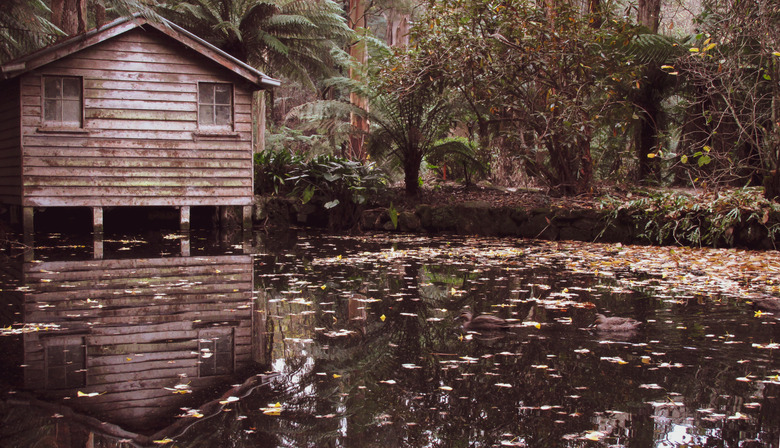Lizards Found In Louisiana
Lizards differ from mammals and other warm-blooded organisms in that they do not generate their own body heat. They depend on the environment for warmth, and their body temperature is essentially the same as the air around them. The warm southerly climate of Louisiana is ideal for cold-blooded lizards, and several species make their home in the state. Lizards in Louisiana range from the anole to the skink.
Green Anole
Green Anole
Two anole species live in Louisiana: the green anole and the brown anole. Green anoles have a limited ability to change their colors, prompting the nickname "false chameleons." Green anoles live in trees, and their toes have sharp claws and invaginated pads adapted to climbing trunks and branches.
Males have an inflatable pink structure called a dewlap on their throats, which puffs up during courtship displays and territorial disputes. If a predator seizes the anole by its long tail, the tail breaks off and the anole escapes. In contrast to brown anoles, which originated in the tropics, green anoles are native to Louisiana.
Prairie Lizard
Prairie Lizard
Sceloporus consobrinus, also known as the prairie lizard or fence lizard, warms up by basking on structures like rocks or fence posts. Such perches also provide a panoramic view, helping them spot the insects and spiders on which they feed. Prairie lizards have a dark coloration, but males have turquoise patches on their underside by which they attract females.
Ranging from 5 to 7 inches in length, these lizards love basking in the sun. They're also able to "drop" or "detach" their tail in order to escape predators faster. The tail will regenerate after it is dropped.
Five-Lined Skink Louisiana
Five-Lined Skink Louisiana
Six species of skinks live in Louisiana, including Plestiodon fasciatus, the five-lined skink. This lizard receives its name from the five whitish lines that run the length of the black body in juvenile skinks. The lines merge into blue in the tail. The color pattern becomes less pronounced as the skink matures, and males lose their lines altogether.
These skinks can be found virtually all over the state, but they do prefer to live in woodlands. They also prefer environments with above average moisture levels, which makes the swamps and bayous of Louisiana perfect for these small lizards. They'll eat almost any insect, spider and other invertebrate species they come across.
Eastern Six-Lined Racerunner
Eastern Six-Lined Racerunner
The eastern six-lined racerunner spends most of its time on the ground. It uses its exceptional speed to escape enemies, and if that does not suffice, it ducks into a burrow. Its preferred habitat is the open countryside, even sandy areas. It tends to avoid the swampy regions of southeastern Louisiana and the dense forests of the north.
Texas Horned Lizard
Texas Horned Lizard
Horned lizards get their name from little spines on their heads. A salient characteristic of these lizards is their habit of scaring would-be assailants by blood that squirts out from their eyes as a result of ruptured blood vessels. The principal part of the Texas horned lizard's range lies further west, but some have crossed over into Louisiana.
Glass Lizards
Glass Lizards
Glass lizards belong to the genus Ophisaurus, a Greek derivative meaning "snake-lizard." They have no legs and look like snakes, but unlike snakes, they can move their eyelids, and their tail breaks into fragments when grabbed by a predator. Three species of glass lizards live in Louisiana.
Mediterranean Gecko
Mediterranean Gecko
Hemidactylus turcicus, the Mediterranean gecko, crossed the Atlantic by ship, established itself in the American tropics and gradually extended its range until it reached Louisiana. They like to live in human habitations, where they run along the walls and ceilings looking for insects to eat. They are nocturnal feeders.
Cite This Article
MLA
Zimmermann, Daniel. "Lizards Found In Louisiana" sciencing.com, https://www.sciencing.com/lizards-found-louisiana-8641923/. 22 November 2019.
APA
Zimmermann, Daniel. (2019, November 22). Lizards Found In Louisiana. sciencing.com. Retrieved from https://www.sciencing.com/lizards-found-louisiana-8641923/
Chicago
Zimmermann, Daniel. Lizards Found In Louisiana last modified March 24, 2022. https://www.sciencing.com/lizards-found-louisiana-8641923/
